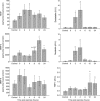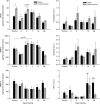Temporal response of positive and negative regulators in response to acute and chronic exercise training in mice
- PMID: 23878369
- PMCID: PMC3810816
- DOI: 10.1113/jphysiol.2013.254979
Temporal response of positive and negative regulators in response to acute and chronic exercise training in mice
Abstract
Angiogenesis is controlled by a balance between positive and negative angiogenic factors, but temporal protein expression of many key angiogenic regulators in response to exercise are still poorly defined. In C57BL/6 mice, we evaluated the temporal protein expression of several pro-angiogenic and anti-angiogenic factors in response to (1) a single acute bout of exercise and (2) chronic exercise training resulting from 3, 5, 7, 14 and 28 days of voluntary wheel running. Following acute exercise, protein levels of vascular endothelial growth factor-A (VEGF), endostatin and nucleolin were increased at 2-4 h (P < 0.05), whereas matrix metalloproteinase (MMP)-2 was elevated within a 12-24 h window (P < 0.05). Training increased muscle capillarity 11%, 15% and 22% starting with 7, 14 and 28 days of training, respectively (P < 0.01). Basal VEGF and MMP-2 were increased by 31% and 22%, respectively, compared to controls (P < 0.05) after 7 days (7d) training, but decreased to back to baseline after 14d training. After 28d training VEGF fell 49% below baseline control (P < 0.01). Basal muscle expression of thrombospondin 1 (TSP-1) was ∼900% greater in 14d- and 28d-trained mice compared to either 5d- and 7d-trained mice (P < 0.05), and tended to increase by ∼180-258% compared to basal control levels (P < 0.10). The acute responsiveness of VEGF to exercise in untrained mice (i.e. 161% increase, P < 0.001) was lost with capillary adaptation occurring after 7, 14 and 28d training. Taken together, these data support the notion that skeletal muscle angiogenesis is controlled by a balance between positive and negative mitogens, and reveals a complex, highly-coordinated, temporal scheme whereby these factors can differentially influence capillary growth in response to acute versus chronic exercise.
Figures




Similar articles
-
Effects of detraining on the temporal expression of positive and negative angioregulatory proteins in skeletal muscle of mice.J Physiol. 2014 Aug 1;592(15):3325-38. doi: 10.1113/jphysiol.2014.271213. Epub 2014 Jun 20. J Physiol. 2014. PMID: 24951625 Free PMC article.
-
Expression of angiogenic regulators and skeletal muscle capillarity in selectively bred high aerobic capacity mice.Exp Physiol. 2011 Nov;96(11):1138-50. doi: 10.1113/expphysiol.2011.057711. Epub 2011 Jul 31. Exp Physiol. 2011. PMID: 21804139
-
Pro- and anti-angiogenic factors in human skeletal muscle in response to acute exercise and training.J Physiol. 2012 Feb 1;590(3):595-606. doi: 10.1113/jphysiol.2011.216135. Epub 2011 Dec 12. J Physiol. 2012. PMID: 22155930 Free PMC article. Clinical Trial.
-
The critical role of VEGF in skeletal muscle angiogenesis and blood flow.Biochem Soc Trans. 2011 Dec;39(6):1556-9. doi: 10.1042/BST20110646. Biochem Soc Trans. 2011. PMID: 22103486 Review.
-
Importance of anti-angiogenic factors in the regulation of skeletal muscle angiogenesis.Microcirculation. 2011 May;18(4):316-30. doi: 10.1111/j.1549-8719.2011.00092.x. Microcirculation. 2011. PMID: 21418382 Review.
Cited by
-
(-)-Epicatechin combined with 8 weeks of treadmill exercise is associated with increased angiogenic and mitochondrial signaling in mice.Front Pharmacol. 2015 Mar 13;6:43. doi: 10.3389/fphar.2015.00043. eCollection 2015. Front Pharmacol. 2015. PMID: 25821434 Free PMC article.
-
High intensity interval and endurance training have opposing effects on markers of heart failure and cardiac remodeling in hypertensive rats.PLoS One. 2015 Mar 24;10(3):e0121138. doi: 10.1371/journal.pone.0121138. eCollection 2015. PLoS One. 2015. PMID: 25803693 Free PMC article.
-
Aging and the Skeletal Muscle Angiogenic Response to Exercise in Women.J Gerontol A Biol Sci Med Sci. 2015 Oct;70(10):1189-97. doi: 10.1093/gerona/glu138. Epub 2014 Sep 2. J Gerontol A Biol Sci Med Sci. 2015. PMID: 25182597 Free PMC article.
-
Advances and challenges in skeletal muscle angiogenesis.Am J Physiol Heart Circ Physiol. 2016 Feb 1;310(3):H326-36. doi: 10.1152/ajpheart.00635.2015. Epub 2015 Nov 25. Am J Physiol Heart Circ Physiol. 2016. PMID: 26608338 Free PMC article. Review.
-
Considerations for aerobic exercise paradigms with rodent models.Lab Anim (NY). 2016 May 20;45(6):213-5. doi: 10.1038/laban.1023. Lab Anim (NY). 2016. PMID: 27203261 No abstract available.
References
-
- Bloor CM. Angiogenesis during exercise and training. Angiogenesis. 2005;8:263–271. - PubMed
-
- Bornstein P. Thrombospondins: structure and regulation of expression. FASEB J. 1992;6:3290–3299. [Published erratum appears in FASEB J (1993) 1, 237. - PubMed
-
- Breen EC, Johnson EC, Wagner H, Tseng HM, Sung LA, Wagner PD. Angiogenic growth factor mRNA responses in muscle to a single bout of exercise. J Appl Physiol. 1996;81:355–361. - PubMed
-
- Brixius K, Schoenberger S, Ladage D, Knigge H, Falkowski G, Hellmich M, Graf C, Latsch J, Montie GL, Prede GL, Bloch W. Long-term endurance exercise decreases antiangiogenic endostatin signalling in overweight men aged 50–60 years. Br J Sports Med. 2008;42:126–129. - PubMed
Publication types
MeSH terms
Substances
LinkOut - more resources
Full Text Sources
Other Literature Sources
Miscellaneous

